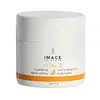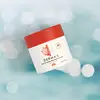What's inside
What's inside
 Key Ingredients
Key Ingredients

 Benefits
Benefits

 Concerns
Concerns

 Ingredients Side-by-side
Ingredients Side-by-side

Aloe Barbadensis Leaf Juice
Skin ConditioningWater
Skin ConditioningGlycerin
HumectantDimethicone
EmollientC12-15 Alkyl Benzoate
AntimicrobialGlyceryl Stearate
EmollientIsostearyl Neopentanoate
EmollientPEG-100 Stearate
Simmondsia Chinensis Seed Oil
EmollientCaprylic/Capric Triglyceride
MaskingCetearyl Alcohol
EmollientCitrus Aurantium Dulcis Oil
MaskingLimonene
PerfumingBrassica Campestris/Aleurites Fordi Oil Copolymer
Skin ConditioningCetyl Alcohol
EmollientTetrahexyldecyl Ascorbate
AntioxidantStearyl Alcohol
EmollientPhenoxyethanol
PreservativeCyclopentasiloxane
EmollientTocopherol
AntioxidantCeteth-10 Phosphate
CleansingDicetyl Phosphate
EmulsifyingMagnesium Ascorbyl Phosphate
AntioxidantPanthenol
Skin ConditioningSqualane
EmollientCaprylyl Glycol
EmollientGlycine Soja Sterols
EmollientLinoleic Acid
CleansingPhospholipids
Skin ConditioningEthylhexylglycerin
Skin ConditioningGlucosamine Hcl
Hexylene Glycol
EmulsifyingXanthan Gum
EmulsifyingMagnesium Aluminum Silicate
AbsorbentPEG-8
HumectantButylene Glycol
HumectantPhytic Acid
Sodium Hydroxide
BufferingPisum Sativum Extract
Skin ConditioningAllantoin
Skin ConditioningRetinyl Palmitate
Skin ConditioningBambusa Vulgaris Leaf/Stem Extract
HumectantCitrus Nobilis Peel Oil
MaskingYeast Polysaccharides
Skin ConditioningDipotassium Glycyrrhizate
HumectantDisodium EDTA
Sodium Hyaluronate
HumectantBenzoic Acid
MaskingAscorbyl Palmitate
AntioxidantPyruvic Acid
MaskingTremella Fuciformis Sporocarp Extract
AntioxidantCitric Acid
BufferingAscorbic Acid
AntioxidantVitis Vinifera Seed Extract
AntimicrobialAloe Barbadensis Leaf Juice, Water, Glycerin, Dimethicone, C12-15 Alkyl Benzoate, Glyceryl Stearate, Isostearyl Neopentanoate, PEG-100 Stearate, Simmondsia Chinensis Seed Oil, Caprylic/Capric Triglyceride, Cetearyl Alcohol, Citrus Aurantium Dulcis Oil, Limonene, Brassica Campestris/Aleurites Fordi Oil Copolymer, Cetyl Alcohol, Tetrahexyldecyl Ascorbate, Stearyl Alcohol, Phenoxyethanol, Cyclopentasiloxane, Tocopherol, Ceteth-10 Phosphate, Dicetyl Phosphate, Magnesium Ascorbyl Phosphate, Panthenol, Squalane, Caprylyl Glycol, Glycine Soja Sterols, Linoleic Acid, Phospholipids, Ethylhexylglycerin, Glucosamine Hcl, Hexylene Glycol, Xanthan Gum, Magnesium Aluminum Silicate, PEG-8, Butylene Glycol, Phytic Acid, Sodium Hydroxide, Pisum Sativum Extract, Allantoin, Retinyl Palmitate, Bambusa Vulgaris Leaf/Stem Extract, Citrus Nobilis Peel Oil, Yeast Polysaccharides, Dipotassium Glycyrrhizate, Disodium EDTA, Sodium Hyaluronate, Benzoic Acid, Ascorbyl Palmitate, Pyruvic Acid, Tremella Fuciformis Sporocarp Extract, Citric Acid, Ascorbic Acid, Vitis Vinifera Seed Extract
Water
Skin ConditioningCarthamus Tinctorius Seed Oil
MaskingStearic Acid
CleansingGlycerin
HumectantGlyceryl Stearate Se
EmulsifyingCetyl Alcohol
EmollientMicrocrystalline Cellulose
AbsorbentCellulose Gum
Emulsion StabilisingPersea Gratissima Oil
Skin ConditioningSesamum Indicum Seed Oil
EmollientHelianthus Annuus Seed Oil
EmollientBakuchiol
AntimicrobialRetinol
Skin ConditioningPanthenol
Skin ConditioningTocopheryl Acetate
AntioxidantAllantoin
Skin ConditioningPhenoxyethanol
PreservativeEthylhexylglycerin
Skin ConditioningParfum
MaskingWater, Carthamus Tinctorius Seed Oil, Stearic Acid, Glycerin, Glyceryl Stearate Se, Cetyl Alcohol, Microcrystalline Cellulose, Cellulose Gum, Persea Gratissima Oil, Sesamum Indicum Seed Oil, Helianthus Annuus Seed Oil, Bakuchiol, Retinol, Panthenol, Tocopheryl Acetate, Allantoin, Phenoxyethanol, Ethylhexylglycerin, Parfum
 Reviews
Reviews

Ingredients Explained
These ingredients are found in both products.
Ingredients higher up in an ingredient list are typically present in a larger amount.
Allantoin is a soothing ingredient known for its protective and moisturizingg properties. Because of this, it is often added to products with strong active ingredients.
Studies show higher concentrations of this ingredient can promote wound healing.
Though it can be derived from the comfrey plant, allantoin is produced synthetically for cosmetic products to ensure purity.
Learn more about AllantoinCetyl Alcohol is a fatty alcohol. Fatty Alcohols are most often used as an emollient or to thicken a product.
Its main roles are:
Though it has "alcohol" in the name, it is not related to denatured alcohol or ethyl alcohol.
The FDA allows products labeled "alcohol-free" to have fatty alcohols.
Learn more about Cetyl AlcoholEthylhexylglycerin (we can't pronounce this either) is commonly used as a preservative and skin softener. It is derived from glyceryl.
You might see Ethylhexylglycerin often paired with other preservatives such as phenoxyethanol. Ethylhexylglycerin has been found to increase the effectiveness of these other preservatives.
Glycerin is already naturally found in your skin. It helps moisturize and protect your skin.
A study from 2016 found glycerin to be more effective as a humectant than AHAs and hyaluronic acid.
As a humectant, it helps the skin stay hydrated by pulling moisture to your skin. The low molecular weight of glycerin allows it to pull moisture into the deeper layers of your skin.
Hydrated skin improves your skin barrier; Your skin barrier helps protect against irritants and bacteria.
Glycerin has also been found to have antimicrobial and antiviral properties. Due to these properties, glycerin is often used in wound and burn treatments.
In cosmetics, glycerin is usually derived from plants such as soybean or palm. However, it can also be sourced from animals, such as tallow or animal fat.
This ingredient is organic, colorless, odorless, and non-toxic.
Glycerin is the name for this ingredient in American English. British English uses Glycerol/Glycerine.
Learn more about GlycerinPanthenol is a common ingredient that helps hydrate and soothe the skin. It is found naturally in our skin and hair.
There are two forms of panthenol: D and L.
D-panthenol is also known as dexpanthenol. Most cosmetics use dexpanthenol or a mixture of D and L-panthenol.
Panthenol is famous due to its ability to go deeper into the skin's layers. Using this ingredient has numerous pros (and no cons):
Like hyaluronic acid, panthenol is a humectant. Humectants are able to bind and hold large amounts of water to keep skin hydrated.
This ingredient works well for wound healing. It works by increasing tissue in the wound and helps close open wounds.
Once oxidized, panthenol converts to pantothenic acid. Panthothenic acid is found in all living cells.
This ingredient is also referred to as pro-vitamin B5.
Learn more about PanthenolPhenoxyethanol is a preservative that has germicide, antimicrobial, and aromatic properties. Studies show that phenoxyethanol can prevent microbial growth. By itself, it has a scent that is similar to that of a rose.
It's often used in formulations along with Caprylyl Glycol to preserve the shelf life of products.
Water. It's the most common cosmetic ingredient of all. You'll usually see it at the top of ingredient lists, meaning that it makes up the largest part of the product.
So why is it so popular? Water most often acts as a solvent - this means that it helps dissolve other ingredients into the formulation.
You'll also recognize water as that liquid we all need to stay alive. If you see this, drink a glass of water. Stay hydrated!
Learn more about Water